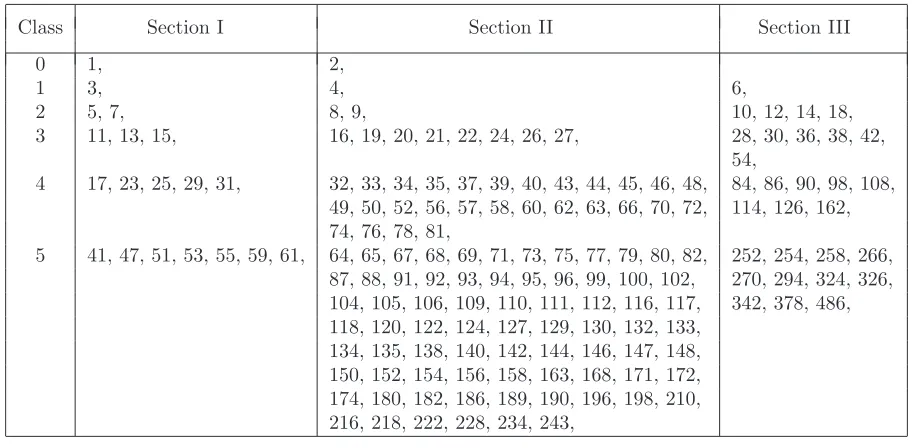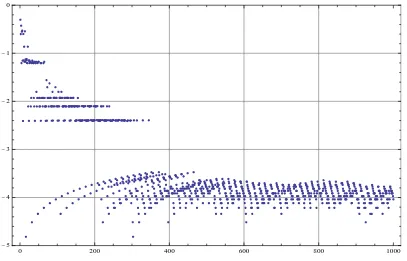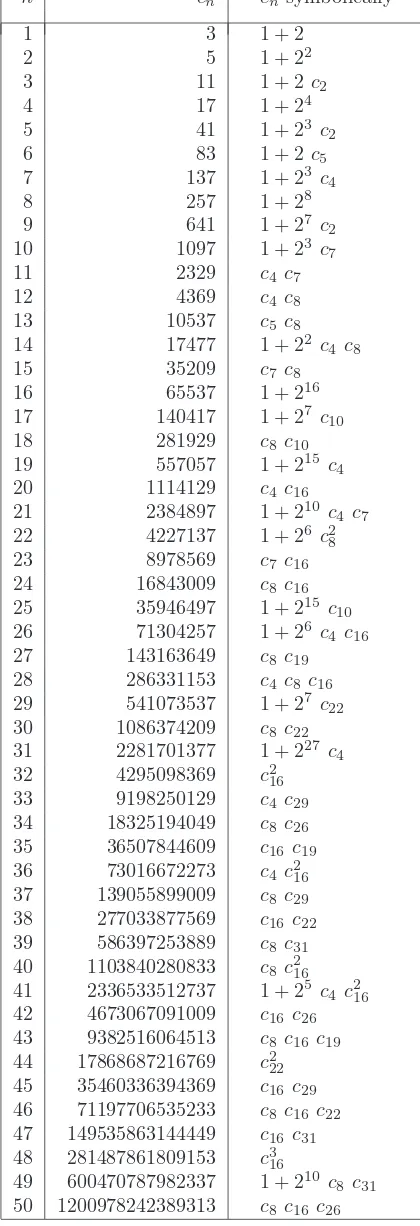23 11
Article 08.1.2
Journal of Integer Sequences, Vol. 11 (2008),
2 3 6 1 47
Primes in Classes of the
Iterated Totient Function
Tony D. Noe
14025 NW Harvest Lane
Portland, OR 97229
USA
[email protected]
Abstract
As shown by Shapiro, the iterated totient function separates integers into classes having three sections. After summarizing some previous results about the iterated totient function, we prove five theorems about primespin a class and the factorization of p−1. An application of one theorem is the calculation of the smallest number in classes up to 1000.
1
Introduction
Letφ(x) denote Euler’s totient function. Definingφ0(x) =x, the iterated totient function is
defined recursively forn > 0 byφn(x) = φ(φn−1(x)). Forx >1,φ(x)< x. Hence, for somen
we will haveφn(x) = 2. Thatx is said to be in classn, and we define the functionC(x) =n.
We defineC(1) = 0. Table1, which is sequenceA058812in Sloane [5], shows the numbers in classes 0 to 5. A thorough treatment of the iterated totient function is given by Shapiro [4]. The normal behavior of this function is treated by Erdos et al. [2]. We summarize key results of Shapiro’s paper here.
2
Properties of the C function
Shapiro establishes the following properties of theC function:
1. For x ory odd,C(xy) =C(x) +C(y).
Class Numbers in this Class
0 1, 2, 1 3, 4, 6,
2 5, 7, 8, 9, 10, 12, 14, 18,
3 11, 13, 15, 16, 19, 20, 21, 22, 24, 26, 27, 28, 30, 36, 38, 42, 54,
4 17, 23, 25, 29, 31, 32, 33, 34, 35, 37, 39, 40, 43, 44, 45, 46, 48, 49, 50, 52, 56, 57, 58, 60, 62, 63, 66, 70, 72, 74, 76, 78, 81, 84, 86, 90, 98, 108, 114, 126, 162,
5 41, 47, 51, 53, 55, 59, 61, 64, 65, 67, 68, 69, 71, 73, 75, 77, 79, 80, 82, 87, 88, 91, 92, 93, 94, 95, 96, 99, 100, 102, 104, 105, 106, 109, 110, 111, 112, 116, 117, 118, 120, 122, 124, 127, 129, 130, 132, 133, 134, 135, 138, 140, 142, 144, 146, 147, 148, 150, 152, 154, 156, 158, 163, 168, 171, 172, 174, 180, 182, 186, 189, 190, 196, 198, 210, 216, 218, 222, 228, 234, 243, 252, 254, 258, 266, 270, 294, 324, 326, 342, 378, 486,
Table 1: Numbers in Classes 0 to 5
3. The largest odd number in class n is 3n; i.e., for oddx, x <3C(x).
4. The largest even number in class n is 2·3n; i.e., for even x,x <2·3C(x).
5. The smallest even number in class n is 2n+1; i.e., for even x, x≥2C(x)+1.
6. The smallest odd number in class n is greater than 2n; i.e., for odd x,x >2C(x).
7. For any integer x, 2C(x) < x≤2·3C(x).
Thus, Shapiro proves that numbers x in classn > 1 fall into three sections:
2n < x <2n+1, 2n+1 ≤x≤3n, 3n < x≤2·3n.
Table 2 shows numbers separated into the three sections. Shapiro establishes the following properties of these classes:
8. Numbers in section I are odd.
9. Numbers in section II are even or odd.
10. Numbers in section III are even.
11. If integer x is in section I, then every divisor ofx is in section I of its class.
Class Section I Section II Section III
0 1, 2,
1 3, 4, 6,
2 5, 7, 8, 9, 10, 12, 14, 18,
3 11, 13, 15, 16, 19, 20, 21, 22, 24, 26, 27, 28, 30, 36, 38, 42, 54,
4 17, 23, 25, 29, 31, 32, 33, 34, 35, 37, 39, 40, 43, 44, 45, 46, 48, 84, 86, 90, 98, 108, 49, 50, 52, 56, 57, 58, 60, 62, 63, 66, 70, 72, 114, 126, 162, 74, 76, 78, 81,
5 41, 47, 51, 53, 55, 59, 61, 64, 65, 67, 68, 69, 71, 73, 75, 77, 79, 80, 82, 252, 254, 258, 266, 87, 88, 91, 92, 93, 94, 95, 96, 99, 100, 102, 270, 294, 324, 326, 104, 105, 106, 109, 110, 111, 112, 116, 117, 342, 378, 486, 118, 120, 122, 124, 127, 129, 130, 132, 133,
134, 135, 138, 140, 142, 144, 146, 147, 148, 150, 152, 154, 156, 158, 163, 168, 171, 172, 174, 180, 182, 186, 189, 190, 196, 198, 210, 216, 218, 222, 228, 234, 243,
Table 2: Numbers in Classes 0 to 5 Organized by Section
Class Numbers in Section I
0 1, 1 3, 2 5, 7, 3 11, 13,15, 4 17, 23,25, 29, 31, 5 41, 47,51, 53,55, 59, 61,
6 83,85, 89, 97, 101, 103, 107, 113,115,119,121,123,125,
7 137, 167, 179,187, 193,205,221, 227, 233,235, 239, 241,249, 251,253,255,
8 257,289, 353, 359, 389,391, 401, 409,411,415,425, 443,445, 449,451, 461, 467, 479,... 9 641,685,697, 719, 769,771, 773,799, 809, 821, 823,835, 857,867, 881, 887,895,901,... 10 1097, 1283,1285, 1361, 1409,1411, 1433, 1439,1445,1507,1513, 1543, 1553, 1601,... 11 2329, 2657, 2741, 2789, 2819,2827,2839, 2879,3043, 3089,3151,3179, 3203,3205,... 12 4369,4913, 5441, 5483,5485,5617, 5639,5911,6001, 6029, 6053,6103, 6173, 6257,...
Table 3: Numbers in Section I of Classes 0 to 12
3
Theorems about primes in classes
Although Shapiro and Catlin give a nice characterization of the composite section I numbers, their papers say little about the prime numbers in sections I and II. We prove five theorems about those primes.
Theorem 1. Suppose p is an odd prime and p= 1 + 2km, with k > 0 and m odd. Then p
is in section I of its class if and only if m is in section I of its class.
Proof. Observe that for prime p, φ(p) = p−1, and hence, C(p−1) = C(p)−1. From
Shapiro’s properties of the C function, we have C(p− 1) = k −1 + C(m). Therefore,
C(p) = C(m) +k. For a primep in section I, we have the inequality
2C(p)< p <2C(p)+1.
Substitutingp= 1 + 2km, we obtain
2C(m)+k<1 + 2km <2C(m)+k+1.
Dividing by 2k produces the inequality
2C(m) < m <2C(m)+1,
showing that m is a number in section I of its class, which is C(p)−k. The proof in the other direction is just as easy. For a number m in section I, we have the inequality
2C(m) < m <2C(m)+1.
Multiplying by 2k produces the inequality
2C(m)+k <2km <2C(m)+k+1.
Adding 1 to 2km does not change the inequality because there is always an odd number
between two evens. Hence, we obtain
2C(m)+k<1 + 2km <2C(m)+k+1.
But, for integers, this inequality is the same as
2C(p)< p <2C(p)+1,
which means pis in section I of its class, which is C(m) +k.
Theorem 2. Suppose p is an odd prime and p= 1 + 2km, with k > 0 and m odd. Then p
is in section II of its class if and only if m is in section II of its class.
Proof. Negating Theorem 1, we have that p is not in Section I if and only if m is not in
Theorem 3. If prime pis in section I of a class, then the factors of p−1are 2 and primes in section I of their class.
Proof. Factor p−1 into the product of an even number and an odd number: p−1 = 2km,
wheremis an odd number andk > 0. By Theorem1,m is a number in section I of its class. Using Shapiro’s Property 11, we conclude that the prime factors ofm are all in section I of their class. Clearly, 2 is also a factor ofp−1, proving the theorem.
Theorem 4. If the smallest number in a class is odd prime p, then the prime factors of
p−1 are 2 and primes that are the smallest numbers in their class.
Proof. From properties of the C function, we know that the smallest number in class n is
either 2n+1 or a number in section I of the class. By assumption, the smallest number is
prime. Hence, the prime p must be in section I. By Theorem 1, if p is a prime in section I and p= 1 + 2km, with k >0 and m odd, thenm is a number in section I of its class. Letq
be a prime factor ofm. Then we can writem=q s and
p= 1 + 2k q s
C(p) =k+C(q) +C(s).
Because m is in section I, by Property 11, q is also. The prime q must be the least number in its class, otherwise if there is a smaller number, p would be smaller (but in the same class), which would contradict the assumption that p is the smallest number in its class. It is obvious that 2 is a prime factor of p−1.
Combining this result with Catlin’s theorem, the next theorem gives us a more complete description of the smallest number in a class.
Theorem 5. Suppose that the smallest number x in a class is odd. If x is composite, then
its prime factors are the smallest numbers in their respective classes. Ifx is prime, then the
prime factors of x−1 are 2 and primes that are the smallest numbers in their respective
classes.
Proof. The composite case is implied by Catlin’s theorem. The prime case is Theorem4.
4
A multiplicative function
For more insight into the odd numbers in sections I and II, it is useful to introduce the function
D(x) = x 2C(x)
for odd integersx. (Here, D could mean “depth”; we want low values of D.) Using Property 1, it is easy to show that D is completely multiplicative; that is, for odd integersx and y,
Observe thatD(x)<2 if and only ifxis in section I of its class. If we write a prime number
p= 1 + 2km with m odd, then it is easy to show that
D(p) = 2−C(p)+D(m).
Hence, if D(m) is very small, then D(p) will be small. Clearly D(1) = 1 is the smallest value of the D function. If F5 = 216+ 1 = 65537 is the largest Fermat prime, then D(F5)
is the second-lowest value of the D function. This value is so low that the first 45426 = ⌊(log 2)/(logD(F5))⌋ powers of F5 are also section I numbers!
5
Computing the least number in a class
Letcn be the least number in class n. For n = 1,2,3, . . . ,16, cn is
3,5,11,17,41,83,137,257,641,1097,2329,4369,10537,17477,35209,65537,
which is sequence A007755. When computing cn, there are two cases to consider: whether
cn is composite or prime. As mentioned above, Catlin proves that when cn is composite, its factors are among the ck for k < n. For instance,
2329 =c11 =c4 c7 and 4369 =c12 =c4 c8.
When cn is prime, we know from Theorem 4 that factors of cn−1 are 2 and prime ck for
k < n. For instance,
1097 =c10 = 1 + 23 c7 and 17477 =c14 = 1 + 22 c4 c8.
For compositecn, it follows from Property 1 that the sum of the subscripts (with repetition) in the product must be n. For prime cn, it follows from Property 1 applied to cn−1 that the sum of the exponent of 2 and subscripts (with repetition) in the product must ben. See Tables 4 and 5for more examples of these formulas.
Hence, Catlin’s theorem and Theorem 4give us the tools for finding the least number in a class. We start with c1 = 3. If the ck are known for k < n, we can compute cn using the
following procedure: First define the set of possible subscripts
Kn ={k < n:ck is prime}.
Second, define the sets of restricted products ofck
Pr =n Ycki :ki ∈Kn, r=Xkio, r= 1,2,3, . . . , n,
that is, all products of primecksuch that the sum of the subscripts isr. Of course,P0 ={1}.
Third, define the set
Qn=
n
[
Here, the notation 1 + 2kPn
−k means that each element of the set Pn−k is multiplied by 2
k
and then incremented by 1. Finally,cn is the smallest of the three quantities: 2n+1, the least
number inPn, and the least prime number in Qn.
We have used the procedure described above, with some optimizations, to computecnfor
n≤1000. For all thesen, we found cn <2n+1, which supports the conjecture that allcn are
odd. The 280 values of n≤1000 for which cn is a provable prime are in sequence A136040. Tables 4 and 5show cn numerically and symbolically for n up to 100.
We found that the first 22 powers (and only those powers) of Fermat prime F5 are the
least numbers in their class, which extends the result of Mills, who found that the first 15 powers ofF5 are the least numbers in their class. Moreover, as shown in the figure below, it
appears that this 22nd power may be an upper bound: we foundD(cn)< D(F22
5 )≈1.00034
for 352< n ≤1000. The change at n= 352 can be explained by there finally being enough primes p having low D(p) values so that for n ≥ 352 the set Kn is large enough to ensure that the Pn and Qn sets have numbers very close to 2n; that is, very low Dvalues.
0 200 400 600 800 1000
-5 -4 -3 -2 -1 0
n cn cn symbolically 34 18325194049 c8 c26 35 36507844609 c16 c19 36 73016672273 c4 c216 37 139055899009 c8 c29 38 277033877569 c16 c22 39 586397253889 c8 c31 40 1103840280833 c8 c216 41 2336533512737 1 + 25
c4 c216 42 4673067091009 c16 c26 43 9382516064513 c8 c16 c19 44 17868687216769 c222 45 35460336394369 c16 c29 46 71197706535233 c8 c16 c22 47 149535863144449 c16 c31 48 281487861809153 c316 49 600470787982337 1 + 210
n cn cn symbolically
51 2278291849363457 1 + 214
c8c29 52 4538923050090497 1 + 214
c16c22 53 9113306453352833 c8c16c29 54 18155969234239553 c216c22 55 38280596832649217 1 + 251
c4 56 72342380484952321 c8c316 57 153129396824244769 c16c41 58 291621356718522497 1 + 27
c51 59 583242713437044737 1 + 222
c8c29 60 1166485424718217217 1 + 230
c8c22 61 2323964066277761153 c216c29 62 4666084093199565121 c8c216c22 63 9800131862897754113 c216c31 64 18447869999386460161 c416 65 39352453561210372097 1 + 226
c8c31 66 74656206327888494657 1 + 26
c8c52 67 148731430780247474177 1 + 222
c16c29 68 297467399933780901889 c16c52 69 592619738273148829697 1 + 229
c8c216 70 1189887755704357584961 c316c22 71 2426509543591652400137 1 + 23
c38c 2 22 72 4741102589842320261377 c8c416 73 9630651773242695532609 c22c51 74 19111988855261800431617 1 + 221
c8c16c29 75 38223977710523600863489 c8c67
76 76447955279757801750529 c16c60 77 152300948808147367100417 1 + 245
c28c16 78 305801153216019899334977 c8c316c22 79 618769376430842916376577 1 + 212
c28c22c29 80 1209018056149790439571457 c516
81 2446371901576743388450817 1 + 212
c8c216c29 82 4892594491879703116251137 1 + 231
c51 83 9747411779045078715138049 c16c67 84 19495120989460198967099393 c216c52 85 38838519787207354851852289 c16c69 86 77981673845596483045589057 c416c22 87 157179431859730823152143377 1 + 24
c216c22c29 88 310717640430496142969864449 c8c516
89 623843871662726366947180577 1 + 25
References
[1] P. A. Catlin, Concerning the iteratedφfunction,Amer. Math. Monthly,77(1970), 60–61.
[2] P. Erdos, A. Granville, C. Pomerance, and C. Spiro, On the normal behavior of the iterates of some arithmetic functions, in: Analytic Number Theory, Proceedings of a
Conference in Honor of P. T. Bateman, Birkhauser, Boston, 1990, 165-204.
[3] W. H. Mills, Iteration of the φ function, Amer. Math. Monthly 50 (1943), 547–549.
[4] Harold Shapiro, An arithmetic function arising from theφfunction,Amer. Math. Monthly
50 (1943), 18–30.
[5] N. J. A. Sloane,The On-Line Encyclopedia of Integer Sequences, published electronically at www.research.att.com/∼njas/sequences.
2000 Mathematics Subject Classification: Primary 11A25.
Keywords: Euler function, iteration, class number.
(Concerned with sequencesA005239,A007755,A058811,A058812,A092878, andA136040.)
Received December 14 2007; revised version received January 7 2008. Published inJournal
of Integer Sequences, January 13 2008.



